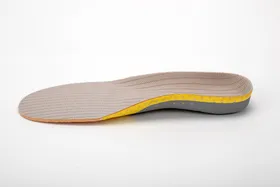Heel Pain When Stretching: Causes and Treatments
Updated December 20, 2024

For the majority of cases of heel pain, stretching the calf muscle and muscles of the foot has been proven to relieve pain and tension in the area, thus reducing your overall experience of symptoms. The causes of heel pain are conditions such as plantar fasciitis, bone spurs, bursitis, and Achilles tendinitis. Determining why you have sore heels is paramount in managing your heel pain going forward. Conservative management strategies like getting a heel massage is usually the first consideration when trying to manage this condition. When dealing with symptoms of pain around the area, stretching can be a great tool in managing various conditions around the body, alongside exercises for heel pain, and other conservative methods. Stretching the calf muscles and plantar muscles of the foot can contribute greatly to overall daily symptom reduction by lengthening the structures around the area of the heel. However, in some circumstances, you can cause your symptoms to get worse.
Causes of Heel Pain When Stretching
Stretching in moderate amounts and without the presence of excessive pain, is deemed beneficial to the body by many, and is used in various forms globally to achieve different outcomes. It is recommended to ensure that you are not over-stretching a muscle or muscle group in the body to achieve a certain result, without doing potential micro-tears to the muscle tissue. It will take time for you to lengthen a muscle group safely.
If a muscle is stretched into a range where the muscle belly and muscle attachments are put under extreme load, you are at further risk for developing micro-tears and inflammation in the tendons. With daily stretching to the end of the range and highly tensioning the muscles repeatedly, the muscles don’t have adequate time to heal and recover from the previous stretching session. High levels of muscle damage are usually then observed in the muscle belly and inflammation in the tendons can arise, otherwise known as tendinitis.
Stretching in some conditions can cause the condition to flare up, usually as a result of over-stretching. Refrain from stretching the aggravated muscle group should this arise or if you suspect you've injured a muscle recently. For more information on these causes, take a look at our post on what causes pain at the back of the heel.
Do’s and Don’ts When Stretching
It is advised to never stretch into high levels of pain. Take your time to warm up the muscles you intend to stretch for approximately ten minutes before your stretching session. Try to avoid stretching cold muscles as this could lead you to be at increased risk of developing micro-tears, as well as potential muscle spasms from occurring. Muscle spasms occur as a result of the body trying to protect itself when adverse tension is placed on the muscle. Functional movements like gentle squats, heel raises, bridging exercises, and ankle pumps are great examples of warm-up exercises you can do.
Apply the stretch slowly to the muscle when stretching muscle groups in the body. Refrain from bouncing in an attempt to increase the stretch further as this could result in pain or injury. In exercises such as the standing heel stretch, breathe slowly as you stretch and avoid pain.
You can stretch the muscles on the underside of the foot by sitting with your foot crossed over your opposite knee in a sitting position. Apply a gentle stretch to the forefoot, pulling the toes back towards the knee. Hold the stretch for 20-30 seconds and repeat several times.
You can also make use of a step to stretch the calf muscles. Place the forefoot on the edge of a step and gently lower the heel downwards. Hold for 20-30 seconds and repeat several times on both legs.
Treatments for Heel Pain From Stretching
It is advised that if stretching is aggravating your symptoms of pain, halt stretching activities, and allow time for the structure to heal. At this stage, you can make use of ice to reduce inflammation in the affected structure. It is also advised to rest the affected structure from all general activities as much as possible if those activities are causing pain.
Reducing exercise is further recommended so to let the inflammation subside. After a period of rest, low-intensity exercise can be done using the affected foot and slowly increase the intensity of exercise as you feel your heel can cope. If the exercise aggravates symptoms thereafter, taper your exercise back and continue with other conservative management strategies for heel pain. Take a look at our posts on What Is Acupressure and How Can It Relieve Heel Pain? and the Benefits of Yoga for Heel Pain.
Another cost-effective way is to get custom-designed insoles for heel pain. The increased cushioning and shock absorption from the orthotics can protect the heel and tissue around it from aggravation during exercise. Massaging the affected area can also help relieve symptoms of heel pain.
When to See a Doctor for Heel Pain
It is advised that you seek the attention of a medical practitioner for the following reasons:
- A loud snap or pop is heard while stretching
- Excessive pain in the Achilles tendon
- You have reduced ability to use a muscle or ankle/foot
- Bruising around the area
- You are unable to put weight on your foot
- Inability to walk for more than 3 days
- Excessive swelling around the ankle or heel
A medical practitioner will take your medical history, examine the affected area, and may send you for diagnostic radiography to further determine the cause of your pain. An MRI, CT scan, and X-ray can all be used to diagnose your condition further.








